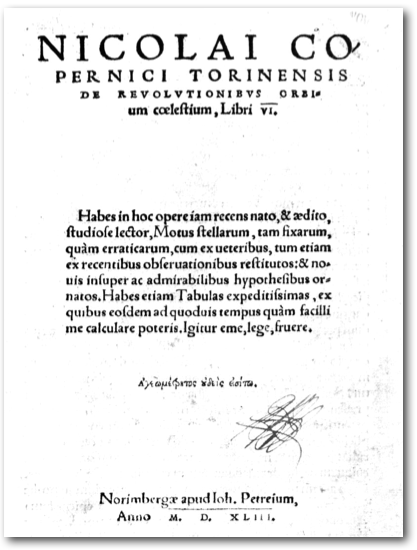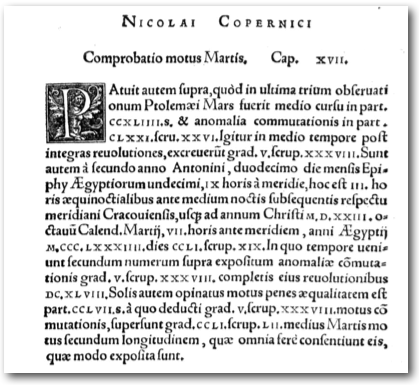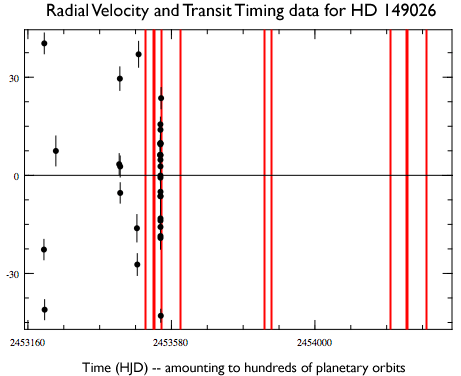
In preparing my talk for the Torun meeting, it seemed appropriate to take a careful look at the book that got the whole planetary systems business going — De revolutionibus orbium coelestium (On the Revolutions of Heavenly Spheres) by Copernicus.
Being not in possession of a classical education, that meant settling for an English translation, but it’s interesting to look at the original Latin editions (which are dramatically out of copyright, and hence available from the ether in the departure lounge at O’Hare if one is willing to fork out for a wi-fi connection). Here’s the frontispiece of Harvard’s edition:

The text translates to:
Diligent reader, in this work, which has just been created and published, you have the motions of the fixed stars and planets, as these motions have been reconstituted on the basis of ancient as well as recent observations, and have moreover been embellished by new and marvelous hypotheses. You also have most convenient tables from which you will be able to compute those motions with the utmost care for any time whatever. Therefore, buy, read and enjoy.
To a modern sensibility, the exhortation to buy the book seems to run at cross purposes with the warning just below (written in Greek for heightened effect):
Let no one untrained in geometry enter here.
Certainly, in trying to make sense of the text, it’s clear that the warning is no empty threat. The book, with its arduous descriptions of ephemerides is tough going. Section 17 of Book V presents a typical example:

Now it was made clear above that in the last of Ptolemy’s three observations Mars, by its mean movement as at 244.5 deg, and its anomaly of parallax was at 171 deg, 26′. Accordingly during the year between there was a movement of 5 deg 38′ besides the complete revolutions. Now for the 2nd year of Antoninus on the 12th day of Epiphi the 11 month by the Egyptian calendar 9 hours after mid-day, i.e. 3 equatorial hours before the following midnight, with respect to the Cracow meridian, to the year of Our Lord 1523 on the 8th day before the Kalends of March 7 hours before noon, there were 1384 Egyptian years 251 days 19 minutes [of a day]. During that time there were by the above calculation 5 deg 38′ and 648 complete revolutions of anomaly of parallax. Now the regular movement of the sun was held to be 257 1/2 deg. The subtraction from 257 1/2 deg of the 5 deg 38′ of the movement of parallax leaves 251 deg 52′ as the mean movement of Mars in longitude. And all that agrees approximately with what was set down just now.
By connecting observations from the Ptolemaic era with his own (and other contemporary) observations, Copernicus was able to achieve a great improvement in timing accuracy. Remarkably, his combination of timing data and positional measurements for solar system planets such as Mars give a signal-to-noise quite similar to the modern data that we currently have for transiting hot Jupiters such as HD 149026b. These extrasolar planets have been observed over hundreds of orbits with both ground-based photometry (for timing) and with radial velocities (for elucidating the orbital figure).

Given that the distances to the planet-bearing stars are millions of times larger than the distances to the solar system planets, this is a testament both to how far we’ve come in 500 years, and simultaneously, to the durability of the Copernican accomplishment.
